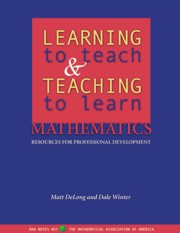Book contents
- Frontmatter
- Preface
- Contents
- 1 The Professional Development Program
- 2 How to Use this Book
- 3 An Orientation Session for the Beginning of the Semester
- 4 Making In-class Groups Work
- 5 Getting Students to Read the Textbook
- 6 Assessing and Evaluating Students' Work
- 7 Managing Homework Teams
- 8 Teaching During Office Hours
- 9 Establishing and Maintaining Control in Your Classroom
- 10 Proctoring Tests and Examinations
- 11 Teaching with Calculators and Computers
- 12 Making Lesson Plans
- 13 Strategies for Motivating Students
- 14 Dealing With Difficult Instructor-Student Situations
- 15 End-of-Semester Administration
- 16 Adapting Materials and Designing Your Own Meetings
- 17 Classroom Visits
- A Tips for Running Meetings
- B The Michigan Introductory Program
- Bibliography
17 - Classroom Visits
- Frontmatter
- Preface
- Contents
- 1 The Professional Development Program
- 2 How to Use this Book
- 3 An Orientation Session for the Beginning of the Semester
- 4 Making In-class Groups Work
- 5 Getting Students to Read the Textbook
- 6 Assessing and Evaluating Students' Work
- 7 Managing Homework Teams
- 8 Teaching During Office Hours
- 9 Establishing and Maintaining Control in Your Classroom
- 10 Proctoring Tests and Examinations
- 11 Teaching with Calculators and Computers
- 12 Making Lesson Plans
- 13 Strategies for Motivating Students
- 14 Dealing With Difficult Instructor-Student Situations
- 15 End-of-Semester Administration
- 16 Adapting Materials and Designing Your Own Meetings
- 17 Classroom Visits
- A Tips for Running Meetings
- B The Michigan Introductory Program
- Bibliography
Summary
Class Visits and Professional Development
Overview of Class Visits
An important component of a professional development program is a system of visits to new instructors' classes. These visits take a substantial amount of time and effort, but they afford many benefits that cannot be gained from other aspects of a professional development program. Through class visits, instructors can get concrete, focused, and personal feedback. Through the sharing of sensible and helpful advice, the course coordinators can gain the respect and trust of their instructors. Visits keep the coordinators connected with the classrooms: the nature of the students, the classroom layout, and developing problems course—wide or with individual instructors. Finally, visits are a valuable tool for assessing and improving the professional development program.
The bulk of the chapter is an explanation of three types of class visits. The types of visits are observational visits, student-feedback visits, and peer visits. The observational visits are conducted by a course coordinator, and are detailed in Section 17.2. The student-feedback visits are also conducted by a course coordinator, but a similar less effective method can be conducted by an instructor in his or her own class. These types of visits are detailed in Section 17.3 and Section 17.4 respectively. Peer visits allow instructors to give and receive feedback, and don't involve the course coordinators.
- Type
- Chapter
- Information
- Learning to Teach and Teaching to Learn MathematicsResources for Professional Development, pp. 205 - 236Publisher: Mathematical Association of AmericaPrint publication year: 2002

